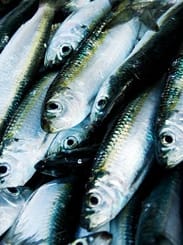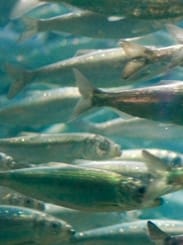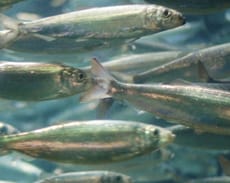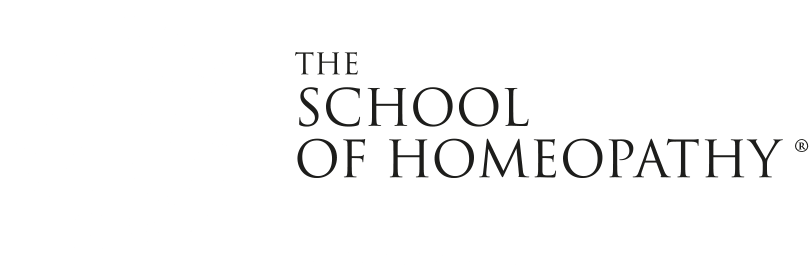

Herring (Clupea Harengus)
Proving date: October 2008
Proving completed by: Misha Norland, Peter Fraser & The School of Homeopathy
Common name : Herring
Download: Full proving Herring (Clupea Harengus)
Download: Proving rubrics
About the Herring
Calmly flowing with time and circumstances, belonging to the group, heaviness, numbness, and confusion of mind and space.
A patient needing Clupea harengus would not think of themselves as separated from their family, group or indeed society. Herrings are obligate schoolers and, like the fish, they shoal together. They naturally accept rules and regulations as binding and necessary for their survival. The remedy has distortions of space, such as feeling taller, and especially distortions of time, time stretching into whatever length is perceived as necessary. This is part of the main theme of the remedy – of flowing with time and circumstances and sensing that everything will work out. There are feelings of calmness, contentment and gratitude. However, profound lethargy and the feeling 'I can't be bothered' can present. Physically, there may be heaviness, exhaustion and sleepiness, to the extent of actual immobility. Mentally, there is profound confusion. This could be of identity and personal boundaries, but is most often expressed as confusion in communication. The patient cannot follow conversations or talk sensibly and is easily distracted. There was a polarity of being energised and able to
do many things at the same time. Also feeling sexy, powerful
and passionate.
Provers got colds that affected the nose, the ears and the eyes, often with severe headaches and an irritating cough. There were many symptoms of the limbs including heaviness, numbness and pain, which was sometimes severe and prevented walking.
Herring
The earliest vertebrates were primitive fish that evolved during the Cambrian period from other primitive creatures with notochords. The term 'fish' describes any non-tetrapod creature with a skull, that has gills throughout its life and whose limbs, if any, are fins. Fish are generally cold-blooded, breathe underwater, have scales and use fins to swim. Most species live either in fresh water or the sea, while some are able to live in both. Fish have specialised nerve cells in the skin enabling them to sense electrical currents emanating from other creatures and objects. They also have a ‘lateral line’ – a series of organs in a canal – running from the head along the sides of the body to detect vibrations and changes in water pressures and currents. They have usual senses of sight, hearing, touch, taste and smell. Being surrounded by water the influence of vibrations are important and while fresh water fish often have good sight, those that live in the depths of the oceans or muddy water have little reliance on vision. Fish generally take no responsibility for their young. Predator fish are often singular hunters, though some team together, most fish swim in shoals and some are mighty schoolers. A school or shoal of fish can be defined as a group travelling in the same direction, orientated by outside stimulus (e.g. the presence of predators or other fish). They usually move at the same speed and are equally spaced from their fellow schoolers.
Herring is a fish found throughout most of the North Atlantic and North Pacific Oceans, and belongs to the Clupeidae family. There are around 200 species and it is the most numerous of all the fish in the ocean. It has been a major food source in Europe and North America for countless centuries. Herring is an obligate schooler and the individual will die if it separates from the group. They are one of the most spectacular ‘schoolers’ due to their rapid and synchronised movements and schools of herring can be enormous (up to 4 cubic kilometres in size, up to a kilometre in length and containing several billion individuals). Migrating herring can come together forming larger schools, and move at considerable speed (up to 4 km/hr). They feed by capturing plankton in their gill rakers as they swim through the water with their mouths open. They are consumed by many ocean fish and cetaceans. Frederick S. Russell in Advances of Marine Biology (1965), states that the behaviour of the herring differs because, unlike other fish which possess a moveable fin, the herring has a rigid, immobile pectoral fin that allows regimented movements within the school. He also suggests the shiny scales enable herrings to find one another in dim light. This also creates a mirroring effect that reflects the surroundings and provides camouflage from predators. Recent research has shown that when light intensity drops the fish scatter, then when it rises once more they come to the surface and begin to school again.
Mythology
Early beliefs: The creation myths of Ancient Africa describe a great creator who plants the first seeds of life that emerge from the ‘cosmic womb’ as fish, ready to journey through the ‘waters of creation’. In Roman mythology, the fish was considered sacred and a symbol of variation and development. In pagan traditions, it was believed that fish symbolised fertility and femininity, and water was considered to be the ‘flow of the Divine Mother principle’ meaning that all creatures residing in the water are products of this goddess. The Ancient Celts hailed the fish as a symbol of knowledge, inspiration and wisdom, particularly the salmon. When they ate salmon they believed they would take on this knowledge. The theme of transformation is reflected in Ancient Eastern Indian mythology when Vishnu changed into a fish to escape a great flood and guide others to safety.
Modern beliefs: In Christianity, the symbolism of fish and its link to Jesus, dates back to the story of feeding the 5,000 with loaves and fishes. In Chinese culture, the fish is seen as a symbol of faithfulness because many species (e.g. the koi carp) swim together in pairs thus the fish motif in jewellery or figurines, features as wedding gifts in China. In Buddhism, the fish is one of the Buddha’s 8 sacred symbols. The pair of fishes originated as the pre-Buddhist symbol of the 2 sacred rivers of India – Ganga and Yamuna. Symbolically, these 2 rivers represent the lunar and solar channels, which originate in the nostrils and carry the alternating rhythms of breath or prana. In Buddhism, fishes symbolise happiness, as they have freedom in water; also fertility and abundance as they multiply rapidly. Both Jesus and Buddha are known as 'fisher of men' because they save mortals from the ocean of suffering.
Astrology: The sign of Pisces is represented by a pair of fish, swimming in opposite directions and the ruling planet is Neptune. The element is Water and the quality is mutable. Characteristics relate to watery themes that are changeable, intuitive and feminine. Personality traits include pessimism, lethargy, being careless, indecisive, submissive, moody, and self-pitying; also selfless, spiritual, kind, compassionate and sympathetic. Piscians often fail to distinguish fact from fantasy, mainly because they are easily caught up in their idealistic and imaginal worlds. Anatomically, Pisces corresponds to feet and toes, lymphatic system, duodenum, and cecum.
History
Red herring: Herring becomes reddish-brown when cured by salting and smoking. A red herring, according to Collins English Dictionary, is 'anything that diverts attention from a topic or line of inquiry'. The phrase came into being in the early 1800s, when an English journalist William Cobbett wrote an anecdote about how he had thrown hounds off the scent of a hare by using a red herring. He used his narrative to criticise the English press which had incorrectly reported a supposed defeat of Napoleon, thereby taking attention away from what he regarded as more pressing domestic affairs.
Herring industry: Herring has been an important local and export food source since medieval times in Britain. Before WWII, 75% of the catch was exported, mainly to Russia and the Baltic countries. Nowadays, 93% of herring from the UK are exported, with most of the haul going to Norway and the Netherlands. Herring destined for the UK market, are mostly distributed as bloaters (lightly smoked herrings) and kippers (herrings which have been gutted and smoked). Spawning is dependent on water temperature, and takes place earlier in the North than the South. Fishing for herring starts in June, in the North, and ends in October/November, in Lowestoft, on the East coast. To a lesser degree, herring is also caught in Devon and Cornwall, in December.
Growth of the UK fishing industry: In the North Sea, fishing boats called drifters, were designed to catch herring in drift nets. The advent of steam power in the 1880s, enabled the industry to expand, and steam drifters and steam trawlers were developed. Steam trawlers could travel further afield, withstand fierce weather and tow larger trawls at greater depths, from the North Atlantic, Iceland and Greenland, as well as the North Sea. Steam engines and new rail transportation networks, soon connected ports to larger towns, bringing ease of supply and distribution of fish across the country, and a growing demand for fish and chips!
The Sea Fishing Industry Act (1933): restricted distant water catches in the Summer and brought in regulations to prevent over-fishing and catching young fish. North Sea stocks grew during WWII but again declined in the post-war period. Since then, a number of international agreements have been drawn up to protect fishing territories and the environment.
The proving
Herring was the last proving at Yondercott in Devon, before the School moved to Stroud, Gloucestershire. One of the surprising things about the proving was a lack of group issues. Modern provings, Animal remedies and provings conducted by an established group, tend to have key 'group' symptoms. Herring, as an obligate schooler, is part of the school and there is no possibility of anything else. The proving demonstrates that group identity predominates, to the extent that an individual fish cannot be regarded (or view itself) as anything other than the collective. Patients needing such a remedy would have issues with identity and boundaries, depending solely upon survival of the group and not regard themselves as being separate from their family, group or society.
Fish remedy themes, identified by ViktÓria Bodrogi in Waterworld – Fish in Homeopathy (2018) include heaviness, wanting freedom and independence. These tie in with concepts described by Jo Evans in Sea Remedies (2009), of being weighed down by responsibility and guilt. Fish and Sea remedies yearn for love, fun, harmony and calm. They may be childish, lost and seeking protection, living in a colourful dreamworld in which time passes slowly. Fish and Sea remedies are changeable like the mother ocean – there may be sadness, anger and irritability. The Fish or Sea remedy patient is the observer in the big swell of the sea, which causes many distortions – their body appears bigger to them, and there is confusion about time and space. Fish and Sea remedies find it difficult to communicate; they are exhausted, confused and drugged, in their isolated solitude. The calm ocean hides a world of darkness, and a group of creatures that Bodrogi says, '... do not show themselves. They are somehow invisible animals, living in a hidden world, yet existing together with the other vertebrates and with humans on the same planet'.
Herring has distortions of space, size and time, the latter of which relates to going with the flow of time and circumstance; everything will work out so there is a sense of calm and flowing, confidence, and contentment. One prover wrote, 'No urgency, loads of time, mind not hurried'. There were also feelings of being blessed and happy, with gratitude and benevolence, which led to a sense of being unruffled. There was great heaviness, lethargy and sleepiness – calm and can't be bothered. Provers felt unable to move but there was also a polarity of being energised and productive, being able to do multiple tasks at the same time. Provers had a need for order, one of whom felt compelled to arrange things on their bedside table in parallel lines, and another who set about vigorously cleaning and tidying their home. There was considerable confusion in the remedy picture, which was most often expressed as confusion in communication and brainfog. Provers were unable to connect their brains to their mouths in order to speak coherently, and could not follow conversations, as they were easily distracted. There were colds that affected the nose, ears and eyes, often with severe headaches and an irritating cough. These were the symptoms of a cold rather than a flu. The heaviness of mind was reflected in physical symptoms with heavy limbs that were numb and painful, and sometimes prevented walking. There were no strong themes or striking imagery in dreams, however, there were echoes of symptoms such as soft vulnerability, and the swelling or importance of breasts. Feeling sexy, powerful and passionate also featured in the proving.
Download: Full proving Herring (Clupea Harengus)
Download: Proving rubrics

Space, size and time - Brainfog - Boundaries - Identity - Calm and flowing - Calm and confident - Calm and content - Calm and can't be bothered - Productive - Feeling sexy - Soft vulnerability
Proving Themes
Kingdom: Animalia
Phylum: Chordata
Class: Actinopterygii
Order: Clupeiformes
Family: Clupeidae
Subfamily: Clupeinae
Genus: Clupea
Species: C.Harengus
Kingdom Taxonomy
I felt a sense of calm relaxation come into me and felt in a space of 'non doing' which felt nice. When I went home I felt a sweetness in me which made me feel especially affectionate towards my partner. This feeling of relaxation continues. I don't feel worried about things.

.jpg)
